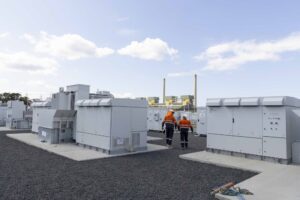Researchers from the Massachusetts Institute of Technology (MIT) say they have developed a supercapacitor which uses two of humanity’s most reliable and trusted materials, cement and carbon black, and they say it could revolutionise energy storage systems.
Cement and carbon black – a material produced by the incomplete combustion of coal – could form the basis of a new and cheap energy storage system.
The MIT researchers say that, when combined with water, the two materials can be formed to make a supercapacitor – an alternative to batteries that can store electrical energy.
They suggest that their newly developed supercapacitor could eventually be incorporated into the concrete foundation of a house. There, it could store a full day’s worth of energy while adding little to no cost and still providing the requisite structural strength.
The researchers also predict that the technology could form the foundation of a concrete roadway that provides contactless recharging for electric vehicles.
The MIT researchers recently published their findings in the journal PNAS.
Put simply, according to MIT, a capacitor consists of “two electrically conductive plates immersed in an electrolyte and separated by a membrane.
“When a voltage is applied across the capacitor, positively charged ions from the electrolyte accumulate on the negatively charged plate, while the positively charged plate accumulates negatively charged ions.
“Since the membrane in between the plates blocks charged ions from migrating across, this separation of charges creates an electric field between the plates, and the capacitor becomes charged.
“The two plates can maintain this pair of charges for a long time and then deliver them very quickly when needed. Supercapacitors are simply capacitors that can store exceptionally large charges.”
The newly developed supercapacitor comes form a method of producing a cement-based material with an extremely high internal surface area due to a dense and interconnected network of conductive material, carbon black, which is highly conductive, within its bulk volume.
“The water naturally forms a branching network of openings within the structure as it reacts with cement, and the carbon migrates into these spaces to make wire-like structures within the hardened cement,” MIT explains.
The resulting large surface area within the confines of a relatively small volume of concrete is then soaked in a standard electrolyte material to provide the charged particles that accumulate on the carbon structures.
Two electrodes made of this type of material, separated by a thin space or an insulating layer, result in a very power supercapacitor.
“The material is fascinating, because you have the most-used man made material in the world, cement, that is combined with carbon black, that is a well-known historical material — the Dead Sea Scrolls were written with it,” said Admir Masic, an associate professor at MIT and co-author of the research.
“You have these at least two-millennia-old materials that when you combine them in a specific manner you come up with a conductive nanocomposite, and that’s when things get really interesting.”
As the mixture sets and cures, explains Masic, “The water is systematically consumed through cement hydration reactions, and this hydration fundamentally affects nanoparticles of carbon because they are hydrophobic (water repelling).”
MIT professor Franz-Josef Ulm, another co-author of the study, highlights the need for cheaper methods of storing variable renewable energy generation from technologies such as wind, solar, and tidal power.
“There is a huge need for big energy storage,” he explains, adding that existing batteries rely on expensive and hard-to-obtain materials such as lithium. Cheaper alternatives are therefore vital.
“That’s where our technology is extremely promising, because cement is ubiquitous,” Ulm says.








